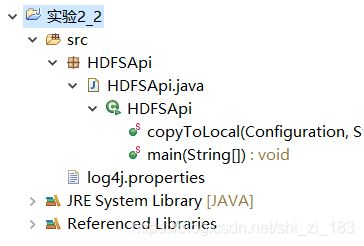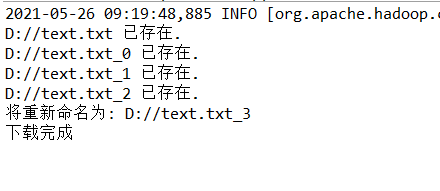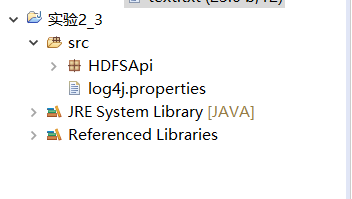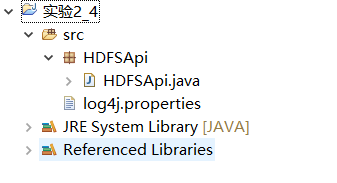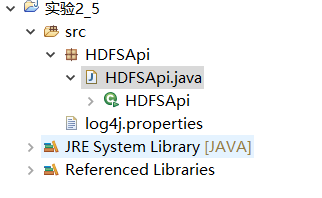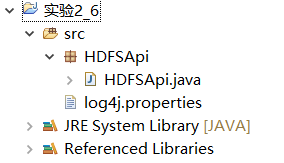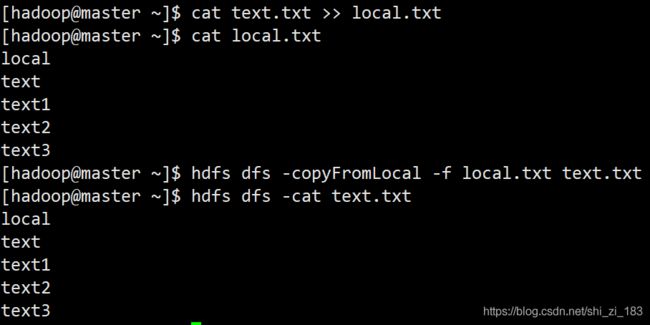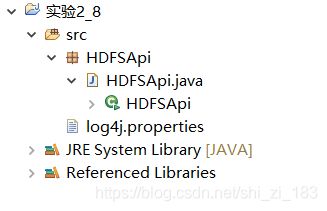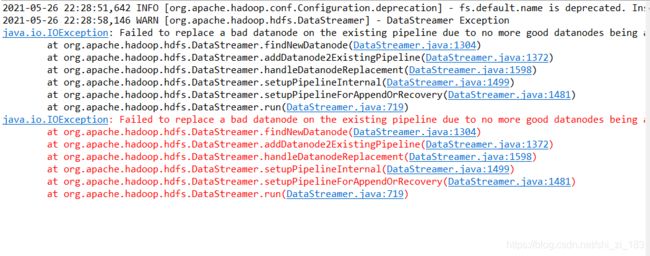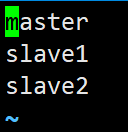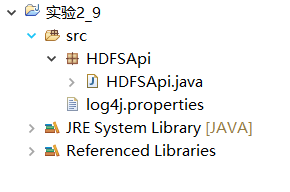实验二:熟悉常用的HDFS操作
实验目的
1、理解HDFS在Hadoop体系结构中的角色
2、熟悉使用HDFS操作常用的Shell命令
3、熟悉HDFS操作常用的Java API
实验平台
1、操作系统:Windows
2、Hadoop版本:3.1.3
3、JDK版本:1.8
4、Java IDE:Eclipse
实验步骤
1、编程实现以下功能,并利用Hadoop提供的Shell命令完成相同任务
1)向 HDFS 中上传任意文本文件,如果指定的文件在 HDFS 中已经存在,则由用户来指定是追加到原有文件末尾还是覆盖原有的文件;
Shell 命令
检查文件是否存在,可以使用如下命令:
cd /usr/local/hadoop
./bin/hdfs dfs -test -e text.txt
执行完上述命令不会输出结果,需要继续输入命令查看结果:
echo $?

如果结果显示文件已经存在,则用户可以选择追加到原来文件末尾或者覆盖原来文件,
具体命令如下:
cd /usr/local/hadoop
./bin/hdfs dfs -appendToFile local.txt text.txt #追加到原文件末尾
./bin/hdfs dfs -copyFromLocal -f local.txt text.txt #覆盖原来文件,第一种命令形式
./bin/hdfs dfs -cp -f file:///home/hadoop/local.txt text.txt#覆盖原来文件,第二种命令形式
实际上,也可以不用上述方法,而是采用如下命令来实现:
if $(hdfs dfs -test -e text.txt);
then $(hdfs dfs -appendToFile local.txt text.txt);
else $(hdfs dfs -copyFromLocal -f local.txt text.txt);
fi

上述代码可视为一行代码,在终端中输入第一行代码后,代码不会立即被执行,可以继续输入第 2 行代码和第 3 行代码,直到输入 fi 以后,上述代码才会真正执行。另外,上述代码中,直接使用了 hdfs 命令,而没有给出命令的路径,因为,这里假设已经配置了 PATH环境变量,把 hdfs 命令的路径“/usr/local/hadoop/bin”写入了 PATH 环境变量中。
Java 代码
我们这里需要一个jar包来实现scphttp://www.ganymed.ethz.ch/ssh2/
项目目录结构如下:
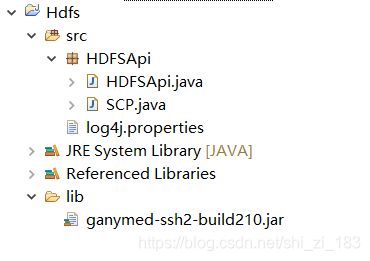
HDFSApi.java
package HDFSApi;
import org.apache.hadoop.conf.Configuration;
import org.apache.hadoop.fs.*;
import java.io.*;
import HDFSApi.SCP;
public class HDFSApi {
/**
* 判断路径是否存在
*/
public static boolean test(Configuration conf, String path) throws IOException {
FileSystem fs = FileSystem.get(conf);
return fs.exists(new Path(path));
}
/**
* 复制文件到指定路径
* 若路径已存在,则进行覆盖
*/
public static void copyFromLocalFile(Configuration conf, String localFilePath, String remoteFilePath) throws IOException {
FileSystem fs = FileSystem.get(conf);
Path localPath = new Path(localFilePath);
Path remotePath = new Path(remoteFilePath);
/* fs.copyFromLocalFile 第一个参数表示是否删除源文件,第二个参数表示是否覆盖 */
fs.copyFromLocalFile(false, true, localPath, remotePath);
fs.close();
}
/**
* 追加文件内容
*/
public static void appendToFile(Configuration conf, String localFilePath, String remoteFilePath) throws IOException {
FileSystem fs = FileSystem.get(conf);
Path remotePath = new Path(remoteFilePath);
/* 创建一个文件读入流 */
FileInputStream in = new FileInputStream(localFilePath);
/* 创建一个文件输出流,输出的内容将追加到文件末尾 */
FSDataOutputStream out = fs.append(remotePath);
/* 读写文件内容 */
byte[] data = new byte[1024];
int read = -1;
while ( (read = in.read(data)) > 0 ) {
out.write(data, 0, read);
}
out.close();
in.close();
fs.close();
}
/**
* 主函数
*
*/
public static void main(String[] args) throws IOException {
SCP.get();//通过SCP将linux上的文件下载到windows上
Configuration conf = new Configuration();
conf.set("fs.default.name","hdfs://192.168.43.200:9000");
String localFilePath = "D:\local.txt"; // 本地路径
String remoteFilePath = "/user/hadoop/text.txt"; // HDFS 路径
String choice = "append"; // 若文件存在则追加到文件末尾
// String choice = "overwrite"; // 若文件存在则覆盖
try {
/* 判断文件是否存在 */
Boolean fileExists = false;
if (HDFSApi.test(conf, remoteFilePath)) {
fileExists = true;
System.out.println(remoteFilePath + " 已存在.");
} else {
System.out.println(remoteFilePath + " 不存在.");
}
/* 进行处理 */
if ( !fileExists) { // 文件不存在,则上传
HDFSApi.copyFromLocalFile(conf, localFilePath, remoteFilePath);
System.out.println(localFilePath + " 已上传至 " + remoteFilePath);
} else if ( choice.equals("overwrite") ) { // 选择覆盖
HDFSApi.copyFromLocalFile(conf, localFilePath, remoteFilePath);
System.out.println(localFilePath + " 已覆盖 " + remoteFilePath);
} else if ( choice.equals("append") ) { // 选择追加
HDFSApi.appendToFile(conf, localFilePath, remoteFilePath);
System.out.println(localFilePath + " 已追加至 " + remoteFilePath);
}
} catch (Exception e) {
e.printStackTrace();
}
}
}
SCP.java
package HDFSApi;
import java.io.IOException;
import ch.ethz.ssh2.Connection;
import ch.ethz.ssh2.SCPClient;
public class SCP {
public static void get() throws IOException{
Connection conn = new Connection("192.168.43.200");
conn.connect();
boolean isAuthenticated = conn.authenticateWithPassword("root", "123456");
if (isAuthenticated == false)
throw new IOException("Authentication failed.");
SCPClient client = new SCPClient(conn);
client.get("/root/local.txt", "D:\");
conn.close();
}
}
log4j.properties
log4j.rootLogger=info,consolePrint,errorFile,logFile
log4j.appender.consolePrint.Encoding = UTF-8
log4j.appender.consolePrint = org.apache.log4j.ConsoleAppender
log4j.appender.consolePrint.Target = System.out
log4j.appender.consolePrint.layout = org.apache.log4j.PatternLayout
log4j.appender.consolePrint.layout.ConversionPattern=%d %p [%c] - %m%n
log4j.appender.logFile.Encoding = UTF-8
log4j.appender.logFile = org.apache.log4j.DailyRollingFileAppender
log4j.appender.logFile.File = D:/eclipse/log4j_properties_runlog/WorldCount_demo_run.log
log4j.appender.logFile.Append = true
log4j.appender.logFile.Threshold = info
log4j.appender.logFile.layout = org.apache.log4j.PatternLayout
log4j.appender.logFile.layout.ConversionPattern = %-d{yyyy-MM-dd HH:mm:ss} [ %t:%r ] - [ %p ] %m%n
log4j.appender.errorFile.Encoding = UTF-8
log4j.appender.errorFile = org.apache.log4j.DailyRollingFileAppender
log4j.appender.errorFile.File = D:/eclipse/log4j_properties_runlog/WorldCount_demo_error.log
log4j.appender.errorFile.Append = true
log4j.appender.errorFile.Threshold = ERROR
log4j.appender.errorFile.layout = org.apache.log4j.PatternLayout
log4j.appender.errorFile.layout.ConversionPattern =%-d{yyyy-MM-dd HH:mm:ss} [ %t:%r ] - [ %p ] %m%n

2)从 HDFS 中下载指定文件,如果本地文件与要下载的文件名称相同,则自动对下载的文件重命名
shell命令
if $(hdfs dfs -test -e file:///home/hadoop/text.txt);
then $(hdfs dfs -copyToLocal text.txt ./text2.txt);
else $(hdfs dfs -copyToLocal text.txt ./text.txt);
fi
package HDFSApi;
import org.apache.hadoop.conf.Configuration;
import org.apache.hadoop.fs.*;
import java.io.*;
public class HDFSApi {
/**
* 下载文件到本地
* 判断本地路径是否已存在,若已存在,则自动进行重命名
*/
public static void copyToLocal(Configuration conf, String remoteFilePath, String localFilePath) throws IOException {
FileSystem fs = FileSystem.get(conf);
Path remotePath = new Path(remoteFilePath);
File f = new File(localFilePath);
/* 如果文件名存在,自动重命名(在文件名后面加上 _0, _1 ...) */
if (f.exists()) {
System.out.println(localFilePath + " 已存在.");
Integer i = 0;
while (true) {
f = new File(localFilePath + "_" + i.toString());
if (!f.exists()) {
localFilePath = localFilePath + "_" + i.toString();
break;
}
i++;
}
System.out.println("将重新命名为: " + localFilePath);
}
// 下载文件到本地
Path localPath = new Path(localFilePath);
fs.copyToLocalFile(remotePath, localPath);
fs.close();
}
/**
* 主函数
*/
public static void main(String[] args) {
Configuration conf = new Configuration();
conf.set("fs.default.name","hdfs://192.168.43.200:9000");
String localFilePath = "D://text.txt"; // 本地路径
String remoteFilePath = "/user/hadoop/text.txt"; // HDFS 路径
try {
HDFSApi.copyToLocal(conf, remoteFilePath, localFilePath);
System.out.println("下载完成");
} catch (Exception e) {
e.printStackTrace();
}
}
}
(3) 将 HDFS 中指定文件的内容输出到终端中
shell命令
hdfs dfs -cat text.txt
package HDFSApi;
import org.apache.hadoop.conf.Configuration;
import org.apache.hadoop.fs.*;
import java.io.*;
public class HDFSApi {
/**
* 读取文件内容
*/
public static void cat(Configuration conf, String remoteFilePath) throws IOException {
FileSystem fs = FileSystem.get(conf);
Path remotePath = new Path(remoteFilePath);
FSDataInputStream in = fs.open(remotePath);
BufferedReader d = new BufferedReader(new InputStreamReader(in));
String line = null;
while ( (line = d.readLine()) != null ) {
System.out.println(line);
}
d.close();
in.close();
fs.close();
}
/**
* 主函数
*/
public static void main(String[] args) {
Configuration conf = new Configuration();
conf.set("fs.default.name","hdfs://192.168.43.200:9000");
String remoteFilePath = "/user/hadoop/text.txt"; // HDFS 路径
try {
System.out.println("读取文件: " + remoteFilePath);
HDFSApi.cat(conf, remoteFilePath);
System.out.println("
读取完成");
} catch (Exception e) {
e.printStackTrace();
}
}
}
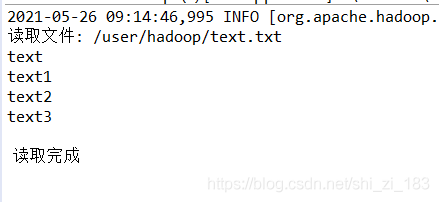
(4) 显示 HDFS 中指定的文件的读写权限、大小、创建时间、路径等信息;
shell命令
hdfs dfs -ls -h text.txt
package HDFSApi;
import org.apache.hadoop.conf.Configuration;
import org.apache.hadoop.fs.*;
import java.io.*;
import java.text.SimpleDateFormat;
public class HDFSApi {
/**
* 显示指定文件的信息
*/
public static void ls(Configuration conf, String remoteFilePath) throws IOException {
FileSystem fs = FileSystem.get(conf);
Path remotePath = new Path(remoteFilePath);
FileStatus[] fileStatuses = fs.listStatus(remotePath);
for (FileStatus s : fileStatuses) {
System.out.println("路径: " + s.getPath().toString());
System.out.println("权限: " + s.getPermission().toString());
System.out.println("大小: " + s.getLen());
/* 返回的是时间戳,转化为时间日期格式 */
Long timeStamp = s.getModificationTime();
SimpleDateFormat format = new SimpleDateFormat("yyyy-MM-dd HH:mm:ss");
String date = format.format(timeStamp);
System.out.println("时间: " + date);
}
fs.close();
}
/**
* 主函数
*/
public static void main(String[] args) {
Configuration conf = new Configuration();
conf.set("fs.default.name","hdfs://192.168.43.200:9000");
String remoteFilePath = "/user/hadoop/text.txt"; // HDFS 路径
try {
System.out.println("读取文件信息: " + remoteFilePath);
HDFSApi.ls(conf, remoteFilePath);
System.out.println("
读取完成");
} catch (Exception e) {
e.printStackTrace();
}
}
}

(5) 给定 HDFS 中某一个目录,输出该目录下的所有文件的读写权限、大小、创建时
间、路径等信息,如果该文件是目录,则递归输出该目录下所有文件相关信息;
shell命令
cd /usr/local/hadoop
./bin/hdfs dfs -ls -R -h /user/hadoop
package HDFSApi;
import org.apache.hadoop.conf.Configuration;
import org.apache.hadoop.fs.*;
import java.io.*;
import java.text.SimpleDateFormat;
public class HDFSApi {
/**
* 显示指定文件夹下所有文件的信息(递归)
*/
public static void lsDir(Configuration conf, String remoteDir) throws IOException {
FileSystem fs = FileSystem.get(conf);
Path dirPath = new Path(remoteDir);
/* 递归获取目录下的所有文件 */
RemoteIterator remoteIterator = fs.listFiles(dirPath, true);
/* 输出每个文件的信息 */
while (remoteIterator.hasNext()) {
FileStatus s = remoteIterator.next();
System.out.println("路径: " + s.getPath().toString());
System.out.println("权限: " + s.getPermission().toString());
System.out.println("大小: " + s.getLen());
/* 返回的是时间戳,转化为时间日期格式 */
Long timeStamp = s.getModificationTime();
SimpleDateFormat format = new SimpleDateFormat("yyyy-MM-dd HH:mm:ss");
String date = format.format(timeStamp);
System.out.println("时间: " + date);
System.out.println();
}
fs.close();
}
/**
* 主函数
*/
public static void main(String[] args) {
Configuration conf = new Configuration();
conf.set("fs.default.name","hdfs://192.168.43.200:9000");
String remoteDir = "/user/hadoop"; // HDFS 路径
try {
System.out.println("(递归)读取目录下所有文件的信息: " + remoteDir);
HDFSApi.lsDir(conf, remoteDir);
System.out.println("读取完成");
} catch (Exception e) {
e.printStackTrace();
}
}
}

(6) 提供一个 HDFS 内的文件的路径,对该文件进行创建和删除操作。如果文件所在
目录不存在,则自动创建目录;
shell命令
if $(hdfs dfs -test -d dir1/dir2);
then $(hdfs dfs -touchz dir1/dir2/filename);
else $(hdfs dfs -mkdir -p dir1/dir2 && hdfs dfs -touchz dir1/dir2/filename);
fi
hdfs dfs -rm dir1/dir2/filename #删除文件
package HDFSApi;
import org.apache.hadoop.conf.Configuration;
import org.apache.hadoop.fs.*;
import java.io.*;
public class HDFSApi {
/**
* 判断路径是否存在
*/
public static boolean test(Configuration conf, String path) throws IOException {
FileSystem fs = FileSystem.get(conf);
return fs.exists(new Path(path));
}
/**
* 创建目录
*/
public static boolean mkdir(Configuration conf, String remoteDir) throws IOException {
FileSystem fs = FileSystem.get(conf);
Path dirPath = new Path(remoteDir);
boolean result = fs.mkdirs(dirPath);
fs.close();
return result;
}
/**
* 创建文件
*/
public static void touchz(Configuration conf, String remoteFilePath) throws IOException {
FileSystem fs = FileSystem.get(conf);
Path remotePath = new Path(remoteFilePath);
FSDataOutputStream outputStream = fs.create(remotePath);
outputStream.close();
fs.close();
}
/**
* 删除文件
*/
public static boolean rm(Configuration conf, String remoteFilePath) throws IOException {
FileSystem fs = FileSystem.get(conf);
Path remotePath = new Path(remoteFilePath);
boolean result = fs.delete(remotePath, false);
fs.close();
return result;
}
/**
* 主函数
*/
public static void main(String[] args) {
Configuration conf = new Configuration();
conf.set("fs.default.name","hdfs://192.168.43.200:9000");
String remoteFilePath = "/user/hadoop/input/text.txt"; // HDFS 路径
String remoteDir = "/user/hadoop/input"; // HDFS 路径对应的目录
try {
/* 判断路径是否存在,存在则删除,否则进行创建 */
if ( HDFSApi.test(conf, remoteFilePath) ) {
HDFSApi.rm(conf, remoteFilePath); // 删除
System.out.println("删除路径: " + remoteFilePath);
} else {
if ( !HDFSApi.test(conf, remoteDir) ) { // 若目录不存在,则进行创建
HDFSApi.mkdir(conf, remoteDir);
System.out.println("创建文件夹: " + remoteDir);
}
HDFSApi.touchz(conf, remoteFilePath);
System.out.println("创建路径: " + remoteFilePath);
}
} catch (Exception e) {
e.printStackTrace();
}
}
}

(7) 提供一个 HDFS 的目录的路径,对该目录进行创建和删除操作。创建目录时,如
果目录文件所在目录不存在,则自动创建相应目录;删除目录时,由用户指定
当该目录不为空时是否还删除该目录;
shell命令
创建目录的命令如下:
hdfs dfs -mkdir -p dir1/dir2
删除目录的命令如下:
hdfs dfs -rmdir dir1/dir2
上述命令执行以后,如果目录非空,则会提示 not empty,删除操作不会执行。如果要
强制删除目录,可以使用如下命令:
hdfs dfs -rm -R dir1/dir2
package HDFSApi;
import org.apache.hadoop.conf.Configuration;
import org.apache.hadoop.fs.*;
import java.io.*;
public class HDFSApi {
/**
* 判断路径是否存在
*/
public static boolean test(Configuration conf, String path) throws IOException {
FileSystem fs = FileSystem.get(conf);
return fs.exists(new Path(path));
}
/**
* 判断目录是否为空
* true: 空,false: 非空
*/
public static boolean isDirEmpty(Configuration conf, String remoteDir) throws IOException {
FileSystem fs = FileSystem.get(conf);
Path dirPath = new Path(remoteDir);
RemoteIterator remoteIterator = fs.listFiles(dirPath, true);
return !remoteIterator.hasNext();
}
/**
* 创建目录
*/
public static boolean mkdir(Configuration conf, String remoteDir) throws IOException {
FileSystem fs = FileSystem.get(conf);
Path dirPath = new Path(remoteDir);
boolean result = fs.mkdirs(dirPath);
fs.close();
return result;
}
/**
* 删除目录
*/
public static boolean rmDir(Configuration conf, String remoteDir) throws IOException {
FileSystem fs = FileSystem.get(conf);
Path dirPath = new Path(remoteDir);
/* 第二个参数表示是否递归删除所有文件 */
boolean result = fs.delete(dirPath, true);
fs.close();
return result;
}
/**
* 主函数
*/
public static void main(String[] args) {
Configuration conf = new Configuration();
conf.set("fs.default.name","hdfs://192.168.43.200:9000");
String remoteDir = "/user/hadoop/input"; // HDFS 目录
Boolean forceDelete = false; // 是否强制删除
try {
/* 判断目录是否存在,不存在则创建,存在则删除 */
if ( !HDFSApi.test(conf, remoteDir) ) {
HDFSApi.mkdir(conf, remoteDir); // 创建目录
System.out.println("创建目录: " + remoteDir);
} else {
if ( HDFSApi.isDirEmpty(conf, remoteDir) || forceDelete ) { // 目录为空或强制删除
HDFSApi.rmDir(conf, remoteDir);
System.out.println("删除目录: " + remoteDir);
} else { // 目录不为空
System.out.println("目录不为空,不删除: " + remoteDir);
}
}
} catch (Exception e) {
e.printStackTrace();
}
}
}

(8) 向HDFS中指定的文件追加内容,由用户指定内容追加到原有文件的开头或结尾;
shell命令
追加到原文件末尾的命令如下:
hdfs dfs -appendToFile local.txt text.txt
追加到原文件的开头,在 HDFS 中不存在与这种操作对应的命令,因此,无法使用一条
命令来完成。可以先移动到本地进行操作,再进行上传覆盖,具体命令如下:
hdfs dfs -get text.txt
cat text.txt >> local.txt
hdfs dfs -copyFromLocal -f local.txt text.txt
package HDFSApi;
import org.apache.hadoop.conf.Configuration;
import org.apache.hadoop.fs.*;
import java.io.*;
public class HDFSApi {
/**
* 判断路径是否存在
*/
public static boolean test(Configuration conf, String path) throws IOException {
FileSystem fs = FileSystem.get(conf);
return fs.exists(new Path(path));
}
/**
* 追加文本内容
*/
public static void appendContentToFile(Configuration conf, String content, String remoteFilePath) throws IOException {
FileSystem fs = FileSystem.get(conf);
Path remotePath = new Path(remoteFilePath);
/* 创建一个文件输出流,输出的内容将追加到文件末尾 */
FSDataOutputStream out = fs.append(remotePath);
out.write(content.getBytes());
out.close();
fs.close();
}
/**
* 追加文件内容
*/
public static void appendToFile(Configuration conf, String localFilePath, String remoteFilePath) throws IOException {
FileSystem fs = FileSystem.get(conf);
Path remotePath = new Path(remoteFilePath);
/* 创建一个文件读入流 */
FileInputStream in = new FileInputStream(localFilePath);
/* 创建一个文件输出流,输出的内容将追加到文件末尾 */
FSDataOutputStream out = fs.append(remotePath);
/* 读写文件内容 */
byte[] data = new byte[1024];
int read = -1;
if(in!=null){
while ( (read = in.read(data)) > 0 ) {
out.write(data, 0, read);
}
}
out.close();
in.close();
fs.close();
}
/**
* 移动文件到本地
* 移动后,删除源文件
*/
public static void moveToLocalFile(Configuration conf, String remoteFilePath, String localFilePath) throws IOException {
FileSystem fs = FileSystem.get(conf);
Path remotePath = new Path(remoteFilePath);
Path localPath = new Path(localFilePath);
fs.moveToLocalFile(remotePath, localPath);
}
/**
* 创建文件
*/
public static void touchz(Configuration conf, String remoteFilePath) throws IOException {
FileSystem fs = FileSystem.get(conf);
Path remotePath = new Path(remoteFilePath);
FSDataOutputStream outputStream = fs.create(remotePath);
outputStream.close();
fs.close();
}
/**
* 主函数
*/
public static void main(String[] args) {
Configuration conf = new Configuration();
conf.set("fs.default.name","hdfs://192.168.43.200:9000");
String remoteFilePath = "/user/hadoop/text.txt"; // HDFS 文件
String content = "新追加的内容
";
//String choice = "after"; //追加到文件末尾
String choice = "before"; // 追加到文件开头
try {
/* 判断文件是否存在 */
if ( !HDFSApi.test(conf, remoteFilePath) ) {
System.out.println("文件不存在: " + remoteFilePath);
} else {
if ( choice.equals("after") ) { // 追加在文件末尾
HDFSApi.appendContentToFile(conf, content, remoteFilePath);
System.out.println("已追加内容到文件末尾" + remoteFilePath);
} else if ( choice.equals("before") ) { // 追加到文件开头
/* 没有相应的 api 可以直接操作,因此先把文件移动到本地*/
/*创建一个新的 HDFS,再按顺序追加内容 */
String localTmpPath = "/user/hadoop/tmp.txt";
// 移动到本地
HDFSApi.moveToLocalFile(conf, remoteFilePath, localTmpPath);
// 创建一个新文件
HDFSApi.touchz(conf, remoteFilePath);
// 先写入新内容
HDFSApi.appendContentToFile(conf, content, remoteFilePath);
// 再写入原来内容
HDFSApi.appendToFile(conf, localTmpPath, remoteFilePath);
System.out.println("已追加内容到文件开头: " + remoteFilePath);
}
}
} catch (Exception e) {
e.printStackTrace();
}
}
}

注:这里选择追加到末尾没有问题,如果追加到头部会产生一个问题
Failed to replace a bad datanode on the existing pipeline due to no more good datanodes being available to try.
FSDataOutputStream out = fs.append(remotePath);
1):如果集群中的文件是空文件,则能追加进去。
2):如果集群中的文件有内容,则追加的时候会报错。
原因是因为hadoop环境中只有两个datanode slave1,slave2,太少的datanode节点导致追加操作错误太多。
解决方法
1、我们将datanode扩展至三个或以上,我们可以将master也加入datanode,这样就有了三个节点。
stop-all.sh #停下hadoop
vi /usr/local/hadoop/etc/hadoop/workers #增加master节点
start-all.sh #启动hadoop
2、在管道中没有可用datanode时,生成新的datanode
我们需要在java代码中添加conf
/**
* dfs.client.block.write.replace-datanode-on-failure.enable=true
* 如果在写入管道中存在一个DataNode或者网络故障时,
* 那么DFSClient将尝试从管道中删除失败的DataNode,
* 然后继续尝试剩下的DataNodes进行写入。
* 结果,管道中的DataNodes的数量在减少。
* enable :启用特性,disable:禁用特性
* 该特性是在管道中添加新的DataNodes。
* 当集群规模非常小时,例如3个节点或更少时,集群管理员可能希望将策略在默认配置文件里面设置为NEVER或者禁用该特性。
* 否则,因为找不到新的DataNode来替换,用户可能会经历异常高的管道写入错误,导致追加文件操作失败
*/
conf.set("dfs.client.block.write.replace-datanode-on-failure.enable", "true");
/**
* dfs.client.block.write.replace-datanode-on-failure.policy=DEFAULT
* 这个属性只有在dfs.client.block.write.replace-datanode-on-failure.enable设置true时有效:
* ALWAYS :当一个存在的DataNode被删除时,总是添加一个新的DataNode
* NEVER :永远不添加新的DataNode
* DEFAULT:副本数是r,DataNode的数时n,只要r >= 3时,或者floor(r/2)大于等于n时
* r>n时再添加一个新的DataNode,并且这个块是hflushed/appended
*/
conf.set("dfs.client.block.write.replace-datanode-on-failure.policy", "NEVER");
(9) 删除 HDFS 中指定的文件
shell命令
hdfs dfs -rm text.txt
package HDFSApi;
import org.apache.hadoop.conf.Configuration;
import org.apache.hadoop.fs.*;
import java.io.*;
public class HDFSApi {
/**
* 删除文件
*/
public static boolean rm(Configuration conf, String remoteFilePath) throws IOException {
FileSystem fs = FileSystem.get(conf);
Path remotePath = new Path(remoteFilePath);
boolean result = fs.delete(remotePath, false);
fs.close();
return result;
}
/**
* 主函数
*/
public static void main(String[] args) {
Configuration conf = new Configuration();
conf.set("fs.default.name","hdfs://192.168.43.200:9000");
String remoteFilePath = "/user/hadoop/text.txt"; // HDFS 文件
try {
if ( HDFSApi.rm(conf, remoteFilePath) ) {
System.out.println("文件删除: " + remoteFilePath);
} else {
System.out.println("操作失败(文件不存在或删除失败)");
}
} catch (Exception e) {
e.printStackTrace();
}
}
}
(10) 在 HDFS 中,将文件从源路径移动到目的路径
shell命令
hdfs dfs -mv text.txt text2.txt
java代码
package HDFSApi;
import org.apache.hadoop.conf.Configuration;
import org.apache.hadoop.fs.*;
import java.io.*;
public class HDFSApi {
/**
* 移动文件
*/
public static boolean mv(Configuration conf, String remoteFilePath, String remoteToFilePath) throws IOException {
FileSystem fs = FileSystem.get(conf);
Path srcPath = new Path(remoteFilePath);
Path dstPath = new Path(remoteToFilePath);
boolean result = fs.rename(srcPath, dstPath);
fs.close();
return result;
}
/**
* 主函数
*/
public static void main(String[] args) {
Configuration conf = new Configuration();
conf.set("fs.default.name","hdfs://192.168.43.200:9000");
String remoteFilePath = "hdfs:///user/hadoop/text.txt"; // 源文件 HDFS 路径
String remoteToFilePath = "hdfs:///user/hadoop/new.txt"; // 目的 HDFS 路径
try {
if ( HDFSApi.mv(conf, remoteFilePath, remoteToFilePath) ) {
System.out.println(" 将文件 " + remoteFilePath + " 移动到 " + remoteToFilePath);
} else {
System.out.println("操作失败(源文件不存在或移动失败)");
}
} catch (Exception e) {
e.printStackTrace();
}
}
}
(二)编程实现一个类“MyFSDataInputStream”
该类继承“org.apache.hadoop.fs.FSDataInputStream”,要求如下:实现按行读取 HDFS 中指定文件的方法“readLine()”,如果读到文件末尾,则返回空,否则返回文件一行的文本。
package HDFSApi;
import org.apache.hadoop.conf.Configuration;
import org.apache.hadoop.fs.FSDataInputStream;
import org.apache.hadoop.fs.FileSystem;
import org.apache.hadoop.fs.Path;
import java.io.*;
public class MyFSDataInputStream extends FSDataInputStream {
public MyFSDataInputStream(InputStream in) {
super(in);
}
/**
* 实现按行读取
* 每次读入一个字符,遇到"
"结束,返回一行内容
*/
public static String readline(BufferedReader br) throws IOException {
char[] data = new char[1024];
int read = -1;
int off = 0;
// 循环执行时,br 每次会从上一次读取结束的位置继续读取
//因此该函数里,off 每次都从 0 开始
while ( (read = br.read(data, off, 1)) != -1 ) {
if (String.valueOf(data[off]).equals("
") ) {
off += 1;
break;
}
off += 1;
}
if (off > 0) {
return String.valueOf(data);
} else {
return null;
}
}
/**
* 读取文件内容
*/
public static void cat(Configuration conf, String remoteFilePath) throws IOException {
FileSystem fs = FileSystem.get(conf);
Path remotePath = new Path(remoteFilePath);
FSDataInputStream in = fs.open(remotePath);
BufferedReader br = new BufferedReader(new InputStreamReader(in));
String line = null;
while ( (line = MyFSDataInputStream.readline(br)) != null ) {
System.out.println(line);
}
br.close();
in.close();
fs.close();
}
/**
* 主函数
*/
public static void main(String[] args) {
Configuration conf = new Configuration();
conf.set("fs.default.name","hdfs://192.168.43.200:9000");
String remoteFilePath = "/user/hadoop/text.txt"; // HDFS 路径
try {
MyFSDataInputStream.cat(conf, remoteFilePath);
} catch (Exception e) {
e.printStackTrace();
}
}
}
(三)输出 HDFS 中指定文件的文本到终端中
查看 Java 帮助手册或其它资料,用“java.net.URL”和“org.apache.hadoop.fs.FsURLSt
reamHandlerFactory”编程完成输出 HDFS 中指定文件的文本到终端中。
package HDFSApi;
import org.apache.hadoop.fs.*;
import org.apache.hadoop.io.IOUtils;
import java.io.*;
import java.net.URL;
public class HDFSApi {
static{
URL.setURLStreamHandlerFactory(new FsUrlStreamHandlerFactory());
}
/**
* 主函数
*/
public static void main(String[] args) throws Exception {
String remoteFilePath = "hdfs://192.168.43.200:9000/user/hadoop/text.txt"; // HDFS 文件
InputStream in = null;
try{
/* 通过 URL 对象打开数据流,从中读取数据 */
in = new URL(remoteFilePath).openStream();
IOUtils.copyBytes(in,System.out,4096,false);
} finally{
IOUtils.closeStream(in);
}
}
}
